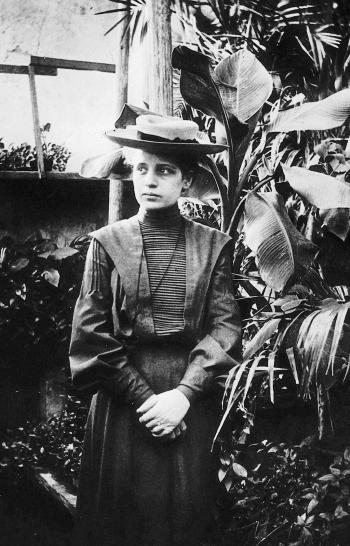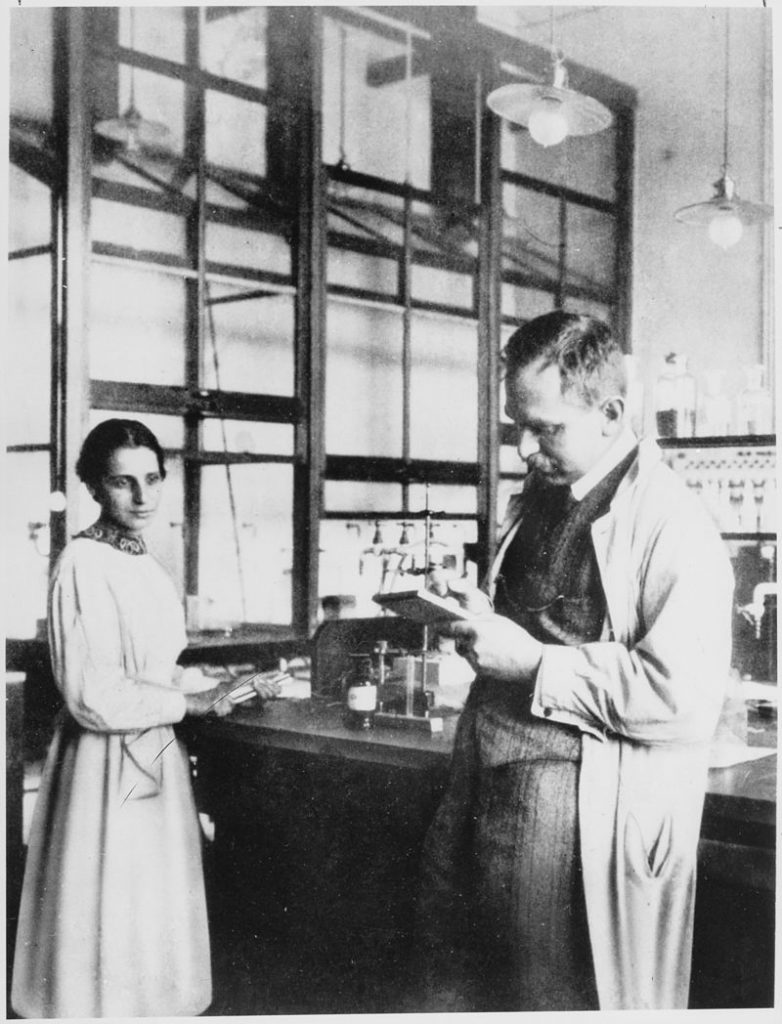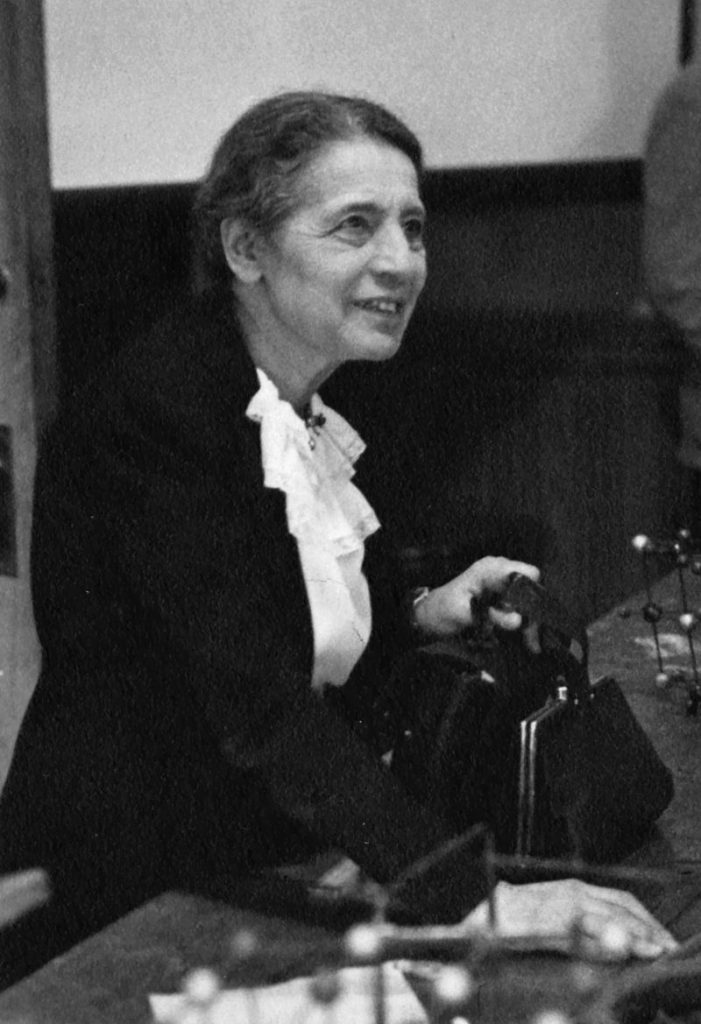Austrian-Swedish physicist Lise Meitner is known for leading a group of scientists, along with Otto Hahn, who were the first to discover that when it absorbed an extra neutron, there was a nuclear fission of uranium. The process they discovered is the process that was the basis for nuclear weapons during World War II.
On November 7, 1878, Elise Meitner was born in Vienna, Austria to Philipp Meitner and Hedwig Skovran. Her father was one of the first Jewish lawyers in the country, as their family was an upper-middle class Jewish family. Lise (she shortened her name later on from Elise) was the third of their eight children. Though when she was older, Meitner converted to Christianity, baptized in 1908.
At age eight, she began keeping a notebook full of her records underneath her pillow. This was Meitner’s earliest research. At a young age, she found herself interested in math and science. She also studied colors of an oil slick along with thin films and rejected light. At the time, women in Vienna were not allowed to attend public higher education institutions. Meitner’s parents supported her though and she was able to attend the private Akademisches Gymnasium, graduating in 1901.
From there, Meitner studied physics. She was the second woman at the university of Vienna to obtain a doctoral degree and she completed her studies in 1905. Meitner did her dissertation on “heat conduction in an inhomogeneous body”.
When she was studying a beam of alpha particles, Meitner discoverer that the atomic mass of the metal atoms increased with scattering. On June 29, 1907, she submitted her report of this to the Physikalische Zeitschrift, a scientific physics journal in Germany.
Meitner was able to receive her doctorate afterwards. She was given an offer to work in a gas lamp factory, but rejected it. Her father continued to encourage her and give her support financially as well. So, she went to Friedrich-Wilhelms-Universität, which was located in Berlin. Max Planck, a notable physicist, did not let women attend his lectures. That was, until he allowed Meitner to while she was studying in Berlin. She continued to attend his lectures for a year until becoming his assistant.
For the first few years as Planck’s assistant, Meitner worked alongside Otto Hahn, a chemist. The two of them discovered many new isotopes while they collaborated. They also were able to discover and develop a method of separation called radioactive recoil. This was where a daughter nucleus is ejected from its matrix forcefully while recoiling at the moment of decay.
Hahn-Meitner, their research group, moved south west of Berlin in 1912 to the Kaiser-Wilhelm-Institute (KWI), which was still new at the time. Meitner did not receive a salary as she worked as a “guest” fin the department of Radiochemistry for Hahn. She would later be given a permanent position at KWI when she was thirty-five in 1913.
Meitner was a nurse for the first part of the Great War. As a nurse, she was in charge of handling X-ray equipment. After a while, she returned to Berlin in 1916 to continue researching. But Meitner went through an inner struggle at the time. She was ashamed with herself for a bit because she returned to scientific research as so many fought in the war and needed bot medical and emotional assistance.
Along with Hahn, Meitner discovered the first long-lived isotope of protactinium, one of the elements. The Berlin Academy of Sciences awarded her with the Leibniz Medal for the discovery. That same year, the KWI gave her her own physics section.
The cause of the emission from electrons surfaces with “signature” energies was discovered in 1922 by Meitner. This was called the Auger effect, named after the scientists from France, Pierre Victor Auger, who discovered the effect the following year.
In 1926, the first woman to assume the post of a full physics professor was Meitner. At the Kaiser Wilhelm Institute for Chemistry, she became the head of the physics department nine years later. Her and Otto Hahn undertook what they called the “transuranium research” program. During the program, they made the unexpected discovery of nuclear fission of heavy nuclei. This was in December of 1938. Albert Einstein even called her the “German Marie Curie”.
Meanwhile, others were making attempts to prove the neutron’s existence. At the same time, Meitner began a correspondence with James Chadwick, who was a physicist in Cambridge at the Cavendish Laboratory. Meitner sent him Polonium to help with his experiments.
Leó Szilárd and Meitner taught a seminar on nuclear physics and chemistry in 1930. In the early 1930s, the neutron was discovered and the scientific community began to speculate the possibility of creating heavier elements than uranium. And thus, a scientific race began with four teams, Ernest Rutherford in Britain, Irene Joliot-Curie in France, Enrico Fermi in Italy, and of course, Meitner and Hahn in Berlin. All of them believed that their abstract research could lead to being honoured with a Nobel prize, but none of them ever thought their research could lead to nuclear weapons.
Adolf Hitler came to power in Germany in 1933 while Meitner was still the head of the physics department at the KWI. Luckily, her Austrian citizenship protected her, but many other Jewish scientists were dismissed/forced to resign. But in March 1938 with the Anschluss (the annexation of Austria into Germany), Meitner found herself in a difficult position. She left Germany for the Netherlands on July 13, 1938 with Hahn’s support and help from Dirk Coster and Adriaan Fokker, two Dutch physicists. She travelled undercover and Coster was able to convince immigration officers that she was given permission. Meitner was able to reach the Netherlands safely, bringing none of her possessions along with her.
However, she was unable to get a job at the University of Groningen. Instead, Meitner moved to Stockholm, Sweden with Eva von Bahr and Carl Wilhelm Oseen’s help. Even though Manne Siegbahn was prejudiced against women working in science, she was able to take up a post at his laboratory. Meitner and Niels Bohr developed a working relationship as he often traveled from Copenhagen to Stockholm. Even though she had left Germany for forever, Meitner did not lose touch with scientists there, as she continued her correspondence with them and with Hahn.
Meitner met with Hahn and Bohr and Otto Frisch (Meitner’s nephew) in Copenhagen on November 10, 1938. At the time, Hahn was giving a lecture at Niels Bohr’s Institute. They continued corresponding afterwards.
Hahn and Fritz Strassmann, is assistant, began performing difficult experiences to isolate the evidence of nuclear fission in December at their laboratory in Berlin. From the correspondence that survives, Hahn believed the fission to be the only explanation for barium and wrote to Meitner about the discovery. Prior to this, Ida Noddack had suggested that there was a possibility of uranium nuclei breaking up under neutron bombardment in 1934. Meitner and Frisch were able to inform Hahn that by using the “liquid-drop” model of the nucleus, that he may be able to split the nucleus of an atom into smaller parts. The two had discovered earlier that the reason there were no stable elements beyond uranium in atomic number was due to the electrical repulsion of the many protons was able to overcome the strong nuclear force. Meitner and Frisch also came to realize that E=mc2, the famous equation of Albert Einstein’s, explained the source of the amount of energy released in nuclear fission. She found herself motivated to begin with these calculations to prove that Irene Joliot-Curie’s interpretation of some experiments was in violation of the liquid drop model.
In December 1938, Hahn and his assistant Strassmann sent Naturwissenschaften, a scientific journal, the first manuscript of their paper. In it, they reported that they had been able to identify the element barium from bombarding uranium with neutrons. Hahn was writing to Meitner of the results, but did not tell any of the physicists he worked alongside. The two published another piece about barium in which they predicted that additional neutrons existed during the fission process. The first to correctly interpret the results as a nuclear fission were Meitner and Frisch, who coined the term.
The scientific community was shocked and electrified when Hahn and Strassmann’s reports were published. It was realized that there was a possibility of fission being used as a weapon, especially since the research was in the hands of Germany. Szilárd, Edward Teller, and Eugene Wigner persuaded Albert einstein to write a letter of caution to President Franklin D. Roosevelt. In 1940, it was discovered how an atomic explosion could be made by Frisch and Rudolf Peierls. This led to the manhattan Project being founded in 1942. Meitner refused to work on the project though and would later say that she was “Sorry that the bomb had been invented.” after the bombings of Hiroshima and Nagasaki in 1945.
Meitner participated in the research on the first nuclear reactor in Sweden called R1. At the time, she had a laboratory at the Royal Institute of Technology in Stockholm. The University College of Stockholm created a personal position for her in 1947. She was given the salary of a professor and the Council for ATomic Research gave her money.
Though Meitner did receive many honors, she never was given the Nobel Prize, which was awarded to Otto Hahn for nuclear fission.
After the war, Meitner was able to visit Germany in the 1950s and 60s. She stayed with Hahn and his family on a few different occasions. The two remained close friends throughout their lives. Becoming a Swedish citizen in 1949, Meitner ended up retiring and moving to the UK in 1960 since most of her family was living there. She did not give up work entirely though and still did some part-time and gave the occasional lecture.
While on a trip to the United States in 1964, Meitner had a heart attack and spent many months recovering. Due to atherosclerosis, her physical and mental health were deteriorating. This prevented her from traveling back to the US to receive the Enrico Fermi prize. In 1967, she broke her hip and suffered many small strokes. Though she was able to partially recover, Meitner was so weak that she moved into a nursing home in Cambridge. Her family thought she took weak to notify her of the deaths of Otto Hahn and his wife, in 1968.
On October 27, 1968, eighty-nine year old Lise Meitner did in her sleep. She was buried in Bramley, Hampshire at the St. James parish church.




